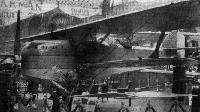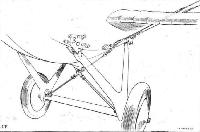Levasseur PL 5 и PL 9
Как и самолет PL 4, двухместный палубный истребитель Levasseur PL 5c, спроектированный в 1924 году инженером Бите, имел фюзеляж-лодку и отличался нижним крылом с малой хордой. Были построены четыре прототипа: три с 450-сильным (336 кВт) двигателем Hispano-Suiza 12Ha, известные как PL 5 AMBC 2, и один с 480-сильным (358 кВт) Renault 12Kd, называвшийся PL 5 C2b. В 1926 году была поставлена партия из 20 самолетов с моторами Lorraine 12Eb.
PL 5 поступили на вооружение палубной эскадрильи 7C1 и сухопутной эскадрильи 3C1. Относительно небольшой размах крыла - 12,36 м, позволял не прибегать к его складыванию при установке на самолетоподъемник авианосца "Беарн", как это делалось с PL 2. Максимальная взлетная масса PL 5 составляла 2130 кг, а максимальная скорость - 215 км/ч. Вооружение включало один неподвижный и два подвижных 7,7-мм пулемета.
Похожий на PL 5, двухместный биплан Levasseur PL 9 поднялся в воздух в августе 1928 года. Предназначенный для обучения экипажей полетам с палубы, он в основном отличался от PL 5 новой конструкцией крыла и поднятыми вверх для улучшения обзора местами инструктора и курсанта. Шесть самолетов, оснащенных двигателями Hispano-Suiza 8Sc в 330 л.с. (246 кВт), под обозначением PL 9 ET.2b несли службу в учебном центре в Ла Паливестре, но из-за проблем с вибрацией двигателя она оказалась сравнительно недолгой и продолжалась с 1934 по 1935 год.
Показать полностьюShow all
Flight, December 1924
The Paris Aero Show 1924
PIERRE LEVASSEUR
SPECIALISTS in avions marins, the Pierre Levasseur firm have this year produced a new type of more than usual interest. In previous years M. Charles Frechet, the very energetic and always amiable managing director of the firm, has had torpedo planes and other craft to show, but this year he has gone a step farther and has produced a type that appears destined to have a very great future. The principle adopted is so simple that one wonders it has not been generally adopted before, and yet the machine would seem to fulfil certain very important requirements in connection with naval co-operation work where a good performance is a valuable asset. Put very briefly, the idea underlying the design of the Pierre Levasseur avion de chasse marin biplace is to provide a machine suitable for work over the sea, capable of taking off from and alighting on the deck of a vessel, having approximately the performance of a land aeroplane of the two-seater fighter type, and being able withal to alight on the sea with reasonable safety should the necessity arise. In the Pierre Levasseur machine all these rather conflicting requirements seem to have been met in a very simple and most ingenious way, the machine being a compromise, certainly, but a compromise which seems to promise extremely well. Although the particular Levasseur biplane is a fighter and reconnaissance machine, there does not appear to be any reason why the same principles could not be applied to commercial machines, in which case a forced alighting on the sea might not have very serious consequences.
The Levasseur avion de chasse marin is, as shown in our photograph, a tractor biplane of fairly orthodox design in its general lay-out. The only notable departure from general practice is the high position of the lower plane. This has, of course, been necessitated by the fact that when the machine is forced to alight on the sea it will float with the lower portion of its fuselage submerged, and it was considered desirable to keep the lower plane clear of the water. This it probably is in a calm sea, at least according to the waterline painted on the sides, but in anything of a seaway the lower wing would doubtless be partly awash. As this wing is of fairly small area, this fact would probably not greatly matter, and in any case the machine is not, and is not intended to be, a seaplane, so that seaworthiness can scarcely be expected. All that the designers intended was to afford the crew a sporting chance in case of a forced descent.
Owing to the high position of the lower plane, the wing bracing is a little unusual in that the lift wires pass through the bottom plane. This could only have been avoided either by placing the fittings above the wing root, in which case the angle would have been poor, or else by running the front wire forward to a point ahead of the wing and the rear wire aft clear of the trailing edge, The designers chose to keep the lift wires in the plane of the struts and run them through the lower plane.
The fuselage is of usual Levasseur construction, but the lower portion has been covered with three-ply up to a height of a little over a foot, and transverse bulkheads in the floor project upwards to above the waterline so that should the machine puncture its fuselage in alighting, the water would not spread to the other compartments. A certain amount of fuselage space is, of course, more or less wasted in this way, but this was probably unavoidable. The bottom of the fuselage is of the vee type, and it seems likely that the machine, with its undercarriage dropped, would alight with very little splash.
The undercarriage is shown in a sketch. It is of usual vee type, but the struts fit into slots in the steel plates on the lower longerons, and axe only held in position by the bracing wires. The latter are locked at the point of crossing by an eccentric device with slots, so that when the small lever is pulled to starboard the cables fall out of their slots and the undercarriage drops.
The main characteristics of the Pierre Levasseur are: Engine, 450 h.p. Hispano-Suiza. Length o.a., 8-8 m. (28 ft. 11 ins.); wing span, 12-4 m. (40 ft. 9 ins.); wing area, 37 sq. m. (400 sq. ft.). Weight empty, 1,150 kgs. (2,530 lbs.); fuel and oil, 300 kgs. (660 lbs.); useful load, 350 kgs. (770 lbs). Total loaded weight, 1,800 kgs. (3,960 lbs.).
The avion marin exhibited in 1922 is shown again this year, but with its covering on. This machine has successfully alighted on the water on several occasions. Pierre Levasseur also shows Levasseur-Reed metal propellers, the French rights for which have been secured by this firm. The S.I.M.B., which recently established a new world's speed record, was fitted with one of these propellers.
Показать полностьюShow all





